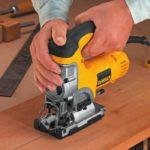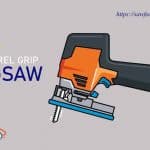For straight, beveled, or angle cut - if any tool is versatile to cover all these cuts is the jigsaw. Carpenters and DIYers alike, everybody just loves using a jigsaw for their project. But even the best player may not perform well if you don’t give it a smooth field to play on!
That’s why when you try to cut plywood with a jigsaw, issues of splinter can piss you off! There are a lot of reasons why splintering is part and parcel of jigsaw cutting, but the good news is, you can avoid it rather easily.
So, in this article, we will show you how to cut plywood without splintering. Stay tuned till the end to find out!
What Is Tear Out or Splintering?

When you are cutting plywood, the thin layer often breaks out at the edge and take a jagged form. This is because the plywood has grain marks.
These marks are there in a straight-line fashion. When you run the blade through these marks, the splintering or tear out happens.
Why Should You Avoid Splintering?
Apart from the fact that it looks ugly, the splinter can cause a few physical damages to the plywood, as well. For example, if you let the splinter or tear out parts as they are, the splinters can cause a larger portion of the plywood to tear out later, too.
If you simply try to take off the parts by your hands, it will ruin the entire piece of plywood, as well. Again, if you are trying to glue one piece of plywood to another, the splintered area will not let you stick it to another part easily.
So these are some of the challenges you will face if you are working with a splintered plywood. That’s why it is crucial to take steps to avoid splintering while you cut.

Image Source: www.manmadediy.com
Know What Causes Plywood Tear Out
It is necessary to identify the causes before working out any problem. There are many reasons for splinting, among which we are pointing out few important reasons about plywood splinter.
Let’s take a look.
- Using cheap and thin plywood
- Cutting too fast
- Wrong saw blade selection
- Lack of preparation
Using Cheap and Thin Plywood
If you are using cheap and thin plywood for your project, the wood will definitely act weird at one point in time. Cheaper and thinner plywood do have weak fiber grains on the surface that the jigsaw will struggle to make an even cut on. So, avoid using thin and cheap plywood.
Cutting Too Fast
When you are running the machine at the top of its speed, you let the device control you instead of you controlling the device. If you are going too fast with the machine, the cuts will be pretty uneven in different places, causing tear outs.
Wrong Saw Blades
If you are using the wrong blade for cutting plywood, you are getting nowhere. You have to use a thin blade to get the job done. The thinner the blade, the better the cutting result. Blades that come with a thinner profile cause a finer cut on the plywood.
Another vital factor is the teeth type. Saw blades come with two basic types of teeth - upward teeth and downward teeth. For the best result, you should always go for an upward one.
Lack of Preparation
Just like hurrying with the machine speed, hurrying with your preparation is also going to backfire. So, take a deep breath and prepare for the cutting process in a steady way. It will save you from many awkward cutting results, including tear-out.
How to cut plywood: Techniques to Prevent Plywood Tear Out
So, now that you know why tear-out or splintering occurs, here’re some pro tips that you need to follow to avoid splintering in plywood cutting with a jigsaw.
Techniques to Prevent Plywood Tear Out
- Buy Good Quality Plywood
- Work with the best jigsaw with perfect speed
- Pick The Right Jigsaw Blade
- Using Splinter Guard
- Using Masking Tape
- Start By Scoring The Cut Line
- Begin Cut from The End
Buy Good Quality Plywood
As we said earlier, poor plywood will cause you only trouble. So, you have to make sure you are using the best quality plywood possible from the market. No matter how good your appliances are, if you are using poor quality plywood, nothing is going to work out well.
Work with the best jigsaw with perfect speed
This goes without saying; you have to use the best jigsaw for plywood cutting job. Not only that, when you have the best one with you, make sure you are using it at the right speed. Neither go too fast nor too slow - pick up the perfect speed for the perfect result.
Pick The Right Jigsaw Blade
Plywood is thin and sensitive, so it needs the right quality blade to cut smoothly. so, the next thing you need to ensure is that you are using the best jigsaw blades for plywood.
Using a thin blade with upward teeth should do quite well in plywood cutting to avoid splintering.
Remember, the jigsaw handles many types of blades. You should use the perfect Types of blades for your cutting Task if you want a splintering less surface.
It's very important to understand TPI lower TPI blades cut fast but rough. However, more TPI blades perform a smoother but more fine cut.
The teeth per inch (TPI) is not the only important thing to consider here. Also, Make sure the blade is sharp.
If you want to choose the best jigsaw blade for cutting playwood without splintering or tear out, there are 4 things you should follow
- High tooth count: High tooth provide more cleen cuts
- Teeth Deration: Upward teeth are the best for avoiding splinters
- Thin kerf:
- More Sharp: A sharp blades helps you avoide splinters
Using Splinter Guard
Using Masking Tape
Masking tape is an age-old technique to avoid splintering. Simply attach masking tape to the area where you are planning to cut, and it will prevent the fibers from dispatching and will stop splintering.
Use A Zero-clearance Insert
If you use a zero-clearance insert, it will match exactly with the blade’s width. It will leave no chance for the wood to shoot out splinters and will present you the clean-cut you are dreaming of.
Start By Scoring The Cut Line
When you have a specific line to follow while you cut, you are never going to deviate. This is a technique that fails once in a blue moon.
So you must make a clear scoring line before you even start cutting. The line will guide you towards the cut and will make sure you are not having any tear-out.

Begin Cut from The End
Never ever try to cut from the middle. It increases the chance of splintering, for sure. Always start from the end of the piece of plywood to get the cleanest cut possible. Go slow, and start from the borderline.
If you are following other codes of conduct in the right way, you will definitely get a clean splintering-free cut.
Final Words
For most newbie carpenters or DIYers, it’s a nightmare to cut plywood as they don’t exactly know how to cut plywood without splintering. But all it takes is a few simple measurements that can prevent this awkward result.
If you are following the guidelines that we have mentioned in this article, we hope that it will get pretty much easier for you to avoid such tear-out —also, you Will become a master of how to cut thin plywood.
So, make sure you get to the root of the problem and solve it as we have mentioned, and enjoy a smooth cut every time!








